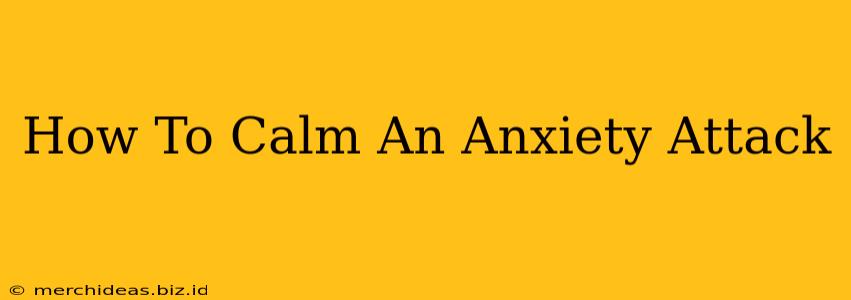Anxiety attacks can feel overwhelming and terrifying, but knowing how to manage them is crucial for your well-being. This guide provides practical techniques you can use to calm an anxiety attack immediately and regain control. Remember, these techniques are not a replacement for professional help; if you experience frequent or severe anxiety attacks, it's vital to seek support from a doctor or therapist.
Understanding Anxiety Attacks
Before diving into coping mechanisms, let's understand what's happening during an anxiety attack. Your body's "fight-or-flight" response is triggered, leading to a cascade of physical symptoms:
- Rapid heartbeat: Your heart races, creating a feeling of palpitations.
- Shortness of breath: You may feel like you're choking or struggling to breathe.
- Sweating: Excessive sweating is a common symptom.
- Trembling: Your body might shake uncontrollably.
- Dizziness or lightheadedness: You may feel faint or unsteady.
- Nausea: Stomach upset is also possible.
- Chest pain: This can mimic a heart attack, causing intense fear.
- Fear of losing control: This overwhelming feeling intensifies the panic.
Recognizing these symptoms can help you understand that you're experiencing an anxiety attack, not a medical emergency (although it's always best to seek medical attention if you're unsure).
Immediate Actions to Calm an Anxiety Attack
When an anxiety attack hits, focus on these techniques to regain control. Remember to breathe deeply and slowly throughout the process:
1. The 5-4-3-2-1 Technique:
This grounding technique helps shift your focus from overwhelming thoughts to the present moment.
- 5 things you can see: Name five things you see around you.
- 4 things you can touch: Describe four things you're touching.
- 3 things you can hear: Identify three sounds you can hear.
- 2 things you can smell: Notice two smells.
- 1 thing you can taste: Identify one taste in your mouth.
2. Box Breathing:
This controlled breathing technique can significantly lower your heart rate and calm your nervous system.
- Inhale: Slowly breathe in through your nose for a count of four.
- Hold: Hold your breath for a count of four.
- Exhale: Slowly exhale through your mouth for a count of four.
- Hold: Hold your breath for a count of four.
- Repeat: Continue this cycle for several minutes.
3. Progressive Muscle Relaxation:
This technique involves tensing and releasing different muscle groups to relieve physical tension, often a contributor to anxiety. Start with your toes, tensing for a few seconds, then releasing. Gradually move upwards, tensing and releasing each muscle group (feet, calves, thighs, etc.) until you reach your head.
4. Mindful Movement:
Gentle movement can help dissipate nervous energy. Try a short walk, some light stretching, or even just gently swaying your body.
5. Positive Self-Talk:
Remind yourself that the attack will pass. Use positive affirmations like "I can handle this," "This feeling is temporary," or "I am safe."
Long-Term Strategies for Managing Anxiety
While the above techniques provide immediate relief, addressing anxiety long-term requires a holistic approach:
- Therapy: Cognitive Behavioral Therapy (CBT) is highly effective for managing anxiety.
- Medication: Your doctor may prescribe medication to help manage symptoms.
- Lifestyle Changes: Regular exercise, a balanced diet, sufficient sleep, and mindfulness practices can significantly reduce anxiety levels.
- Support System: Lean on friends, family, or support groups for emotional support.
Remember: Seeking professional help is a sign of strength, not weakness. Don't hesitate to reach out to a doctor or therapist if you're struggling with anxiety. You deserve to feel calm and in control of your life.
